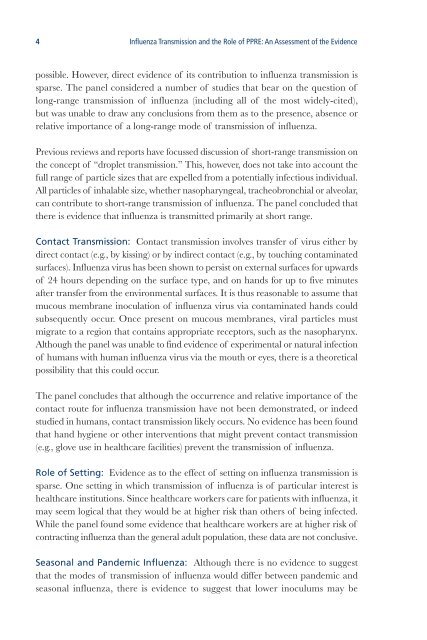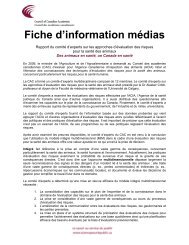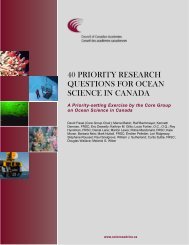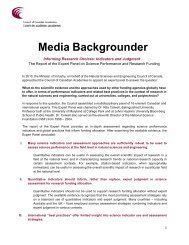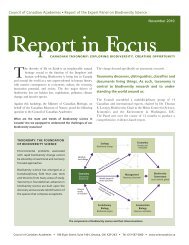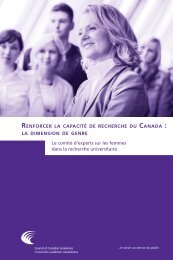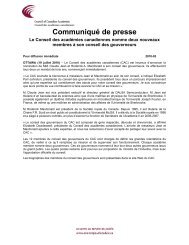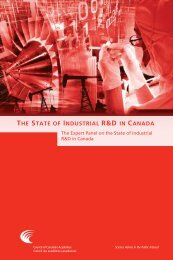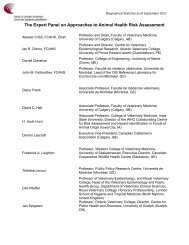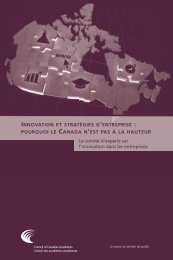an assessment of the evidence - Council of Canadian Academies
an assessment of the evidence - Council of Canadian Academies
an assessment of the evidence - Council of Canadian Academies
- No tags were found...
You also want an ePaper? Increase the reach of your titles
YUMPU automatically turns print PDFs into web optimized ePapers that Google loves.
4 Influenza Tr<strong>an</strong>smission <strong>an</strong>d <strong>the</strong> Role <strong>of</strong> PPRE: An Assessment <strong>of</strong> <strong>the</strong> Evidencepossible. However, direct <strong>evidence</strong> <strong>of</strong> its contribution to influenza tr<strong>an</strong>smission issparse. The p<strong>an</strong>el considered a number <strong>of</strong> studies that bear on <strong>the</strong> question <strong>of</strong>long-r<strong>an</strong>ge tr<strong>an</strong>smission <strong>of</strong> influenza (including all <strong>of</strong> <strong>the</strong> most widely-cited),but was unable to draw <strong>an</strong>y conclusions from <strong>the</strong>m as to <strong>the</strong> presence, absence orrelative import<strong>an</strong>ce <strong>of</strong> a long-r<strong>an</strong>ge mode <strong>of</strong> tr<strong>an</strong>smission <strong>of</strong> influenza.Previous reviews <strong>an</strong>d reports have focussed discussion <strong>of</strong> short-r<strong>an</strong>ge tr<strong>an</strong>smission on<strong>the</strong> concept <strong>of</strong> “droplet tr<strong>an</strong>smission.” This, however, does not take into account <strong>the</strong>full r<strong>an</strong>ge <strong>of</strong> particle sizes that are expelled from a potentially infectious individual.All particles <strong>of</strong> inhalable size, whe<strong>the</strong>r nasopharyngeal, tracheobronchial or alveolar,c<strong>an</strong> contribute to short-r<strong>an</strong>ge tr<strong>an</strong>smission <strong>of</strong> influenza. The p<strong>an</strong>el concluded that<strong>the</strong>re is <strong>evidence</strong> that influenza is tr<strong>an</strong>smitted primarily at short r<strong>an</strong>ge.Contact Tr<strong>an</strong>smission: Contact tr<strong>an</strong>smission involves tr<strong>an</strong>sfer <strong>of</strong> virus ei<strong>the</strong>r bydirect contact (e.g., by kissing) or by indirect contact (e.g., by touching contaminatedsurfaces). Influenza virus has been shown to persist on external surfaces for upwards<strong>of</strong> 24 hours depending on <strong>the</strong> surface type, <strong>an</strong>d on h<strong>an</strong>ds for up to five minutesafter tr<strong>an</strong>sfer from <strong>the</strong> environmental surfaces. It is thus reasonable to assume thatmucous membr<strong>an</strong>e inoculation <strong>of</strong> influenza virus via contaminated h<strong>an</strong>ds couldsubsequently occur. Once present on mucous membr<strong>an</strong>es, viral particles mustmigrate to a region that contains appropriate receptors, such as <strong>the</strong> nasopharynx.Although <strong>the</strong> p<strong>an</strong>el was unable to find <strong>evidence</strong> <strong>of</strong> experimental or natural infection<strong>of</strong> hum<strong>an</strong>s with hum<strong>an</strong> influenza virus via <strong>the</strong> mouth or eyes, <strong>the</strong>re is a <strong>the</strong>oreticalpossibility that this could occur.The p<strong>an</strong>el concludes that although <strong>the</strong> occurrence <strong>an</strong>d relative import<strong>an</strong>ce <strong>of</strong> <strong>the</strong>contact route for influenza tr<strong>an</strong>smission have not been demonstrated, or indeedstudied in hum<strong>an</strong>s, contact tr<strong>an</strong>smission likely occurs. No <strong>evidence</strong> has been foundthat h<strong>an</strong>d hygiene or o<strong>the</strong>r interventions that might prevent contact tr<strong>an</strong>smission(e.g., glove use in healthcare facilities) prevent <strong>the</strong> tr<strong>an</strong>smission <strong>of</strong> influenza.Role <strong>of</strong> Setting: Evidence as to <strong>the</strong> effect <strong>of</strong> setting on influenza tr<strong>an</strong>smission issparse. One setting in which tr<strong>an</strong>smission <strong>of</strong> influenza is <strong>of</strong> particular interest ishealthcare institutions. Since healthcare workers care for patients with influenza, itmay seem logical that <strong>the</strong>y would be at higher risk th<strong>an</strong> o<strong>the</strong>rs <strong>of</strong> being infected.While <strong>the</strong> p<strong>an</strong>el found some <strong>evidence</strong> that healthcare workers are at higher risk <strong>of</strong>contracting influenza th<strong>an</strong> <strong>the</strong> general adult population, <strong>the</strong>se data are not conclusive.Seasonal <strong>an</strong>d P<strong>an</strong>demic Influenza: Although <strong>the</strong>re is no <strong>evidence</strong> to suggestthat <strong>the</strong> modes <strong>of</strong> tr<strong>an</strong>smission <strong>of</strong> influenza would differ between p<strong>an</strong>demic <strong>an</strong>dseasonal influenza, <strong>the</strong>re is <strong>evidence</strong> to suggest that lower inoculums may be


